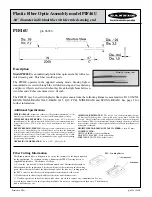
.04" diameter individual fiber with ferruled sensing end
Plastic Fiber Optic Assembly model PIF46U
PIF46U
p/n 26036
SENSING RANGE:
A function of the sensor. For further information, see the
data sheet packed with the sensor, or refer to the Banner product catalog.
TEMPERATURE
EXTREMES:
Temperatures below -30°C will cause
embrittlement of the plastic materials but will not cause transmission loss.
Temperatures above +70°C will cause both transmission loss and fiber
shrinkage.
REPEAT BENDING/FLEXING:
Life expectancy of plastic fiber optic cable
is in excess of one million cycles at bend radii of no less than the minimum
(stated at right) and a bend of 90 degrees or less. Avoid stress at the point where
the cable enters the sensor ("control end") and at the sensing end tip. Coiled
plastic fiberoptic assemblies are recommended for any application requiring
reciprocating fiber motion.
OPERATING TEMPERATURE:
-30 to +70°C (-20 to +158°F).
CHEMICAL RESISTANCE:
The acrylic core of the monofilament opti-
cal fiber will be damaged by contact with acids, strong bases (alkalis) and
solvents. The polyethylene jacket will protect the fiber from most chemical
environments. However, materials may migrate through the jacket with long
term exposure. Samples of fiber optic material are available from Banner for
testing and evaluation.
MINIMUM BEND RADIUS OF PLASTIC FIBER:
1 inch (25 mm)
CONSTRUCTION:
OPTICAL FIBER: acrylic monofilament
PROTECTIVE JACKET: black polyethylene
FERRULED END TIP: T303 stainless steel
This Banner plastic fiber is designed to be cut by the customer to the length required
for the application. To facilitate cutting, a Banner model PFC-1 cutting device is
supplied with this fiber. Cut the fiber as follows:
1) Locate the "control end" of the fiber (the unfinished end). Determine the length of
fiber required for the application. Lift the top (blade) of the cutter to open the cutting
ports. Insert the control end of the fiber through one of the four
large
cutting ports on
the PFC-1 cutter so that the excess fiber protrudes from the back of the cutter.
2) Double-check the fiber length, and close the cutter until the fiber is cut.
3) Gently wipe the cut ends of the fiber with a clean, dry cloth to remove any contamination. Do not
use solvents or abrasives on any exposed optical fiber. Do not use a cutting port more than once. The blade may
tend to dull after one cut.
PFC-1 Cutting Device
Fiber Cutting Information
Additional Specifications
Printed in USA
p/n 03435L4B
Model PIF46U
is an individual plastic fiber optic assembly with a fer-
ruled sensing end. This fiber is sold in pairs.
The PIF46U operates in the opposed sensing mode. Sensing light is
transmitted or received through the ferruled sensing end (see drawing
and photo). Objects are detected when they break the light beam between
two fiber ends. Fiber core diameter is .04 inch.
The PIF46U may be used with plastic fiber optic sensors from the following Banner sensor families: D12, OMNI-
BEAM, MAXI-BEAM, VALU-BEAM, Q45, Q19, PC44, MINI-BEAM, and ECONO-BEAM. See page 2 for
further information.
Ferruled sensing ends
Description


